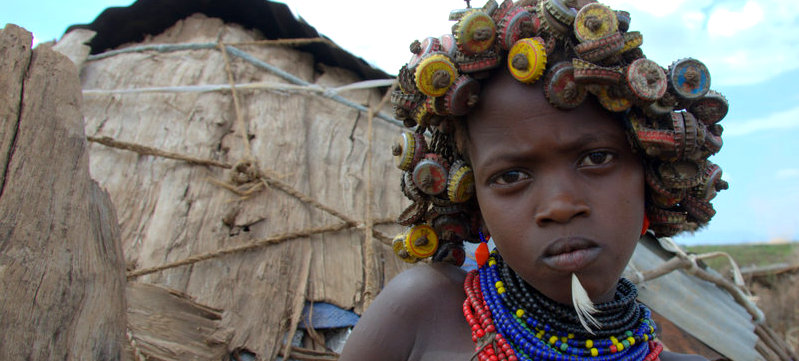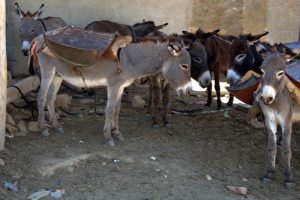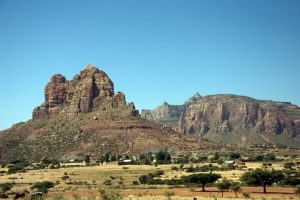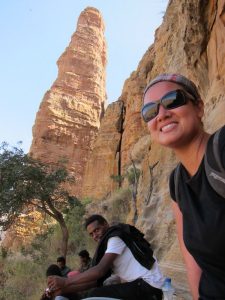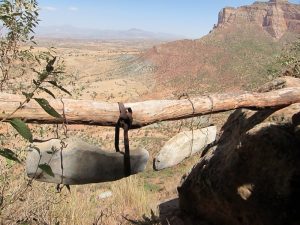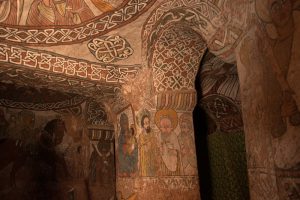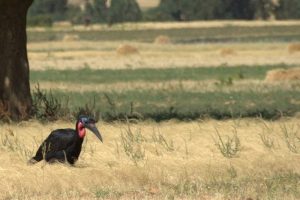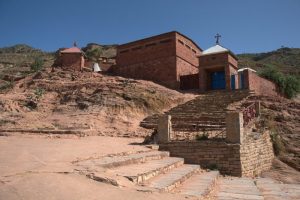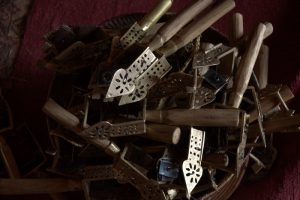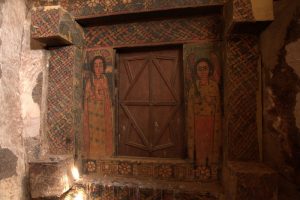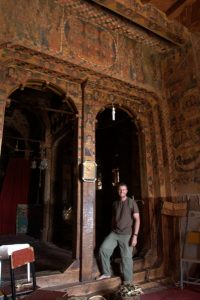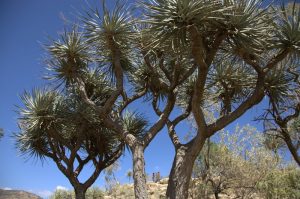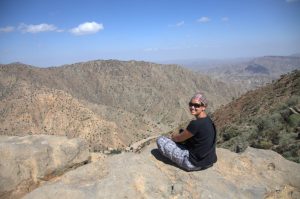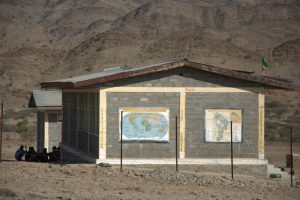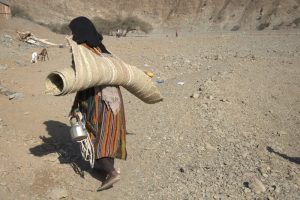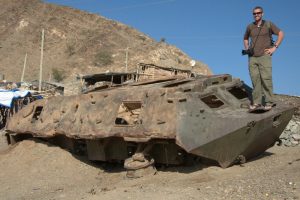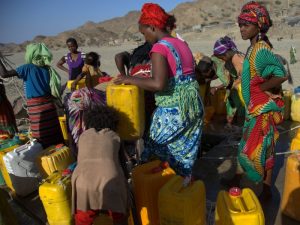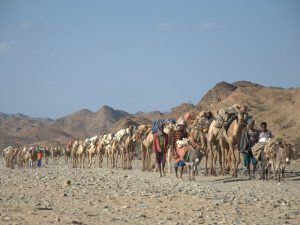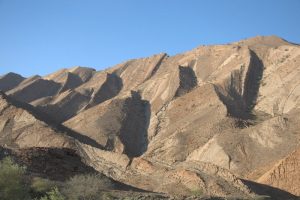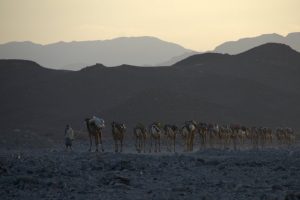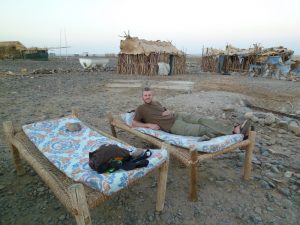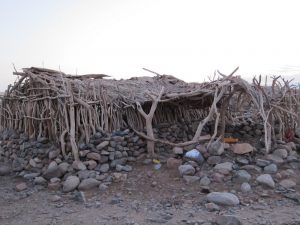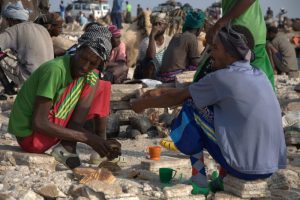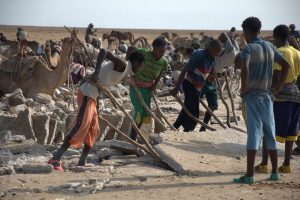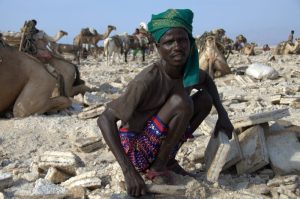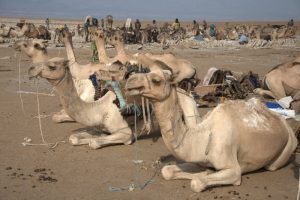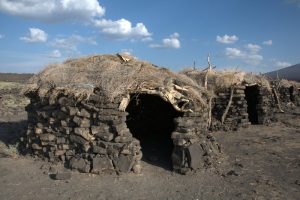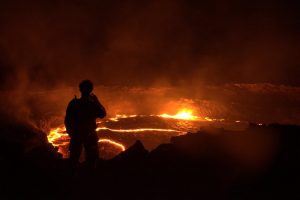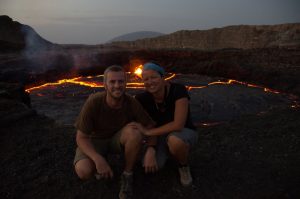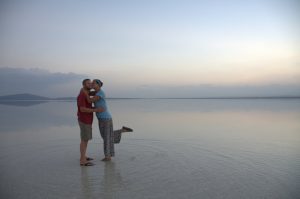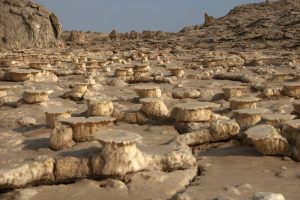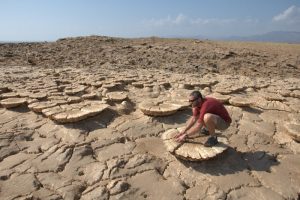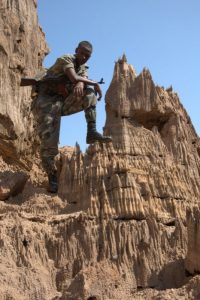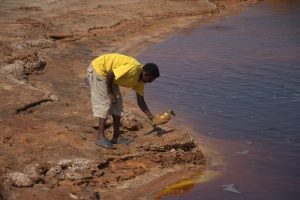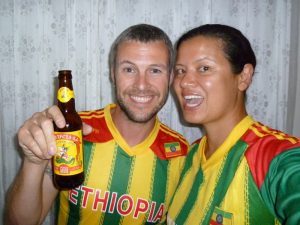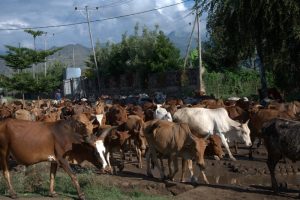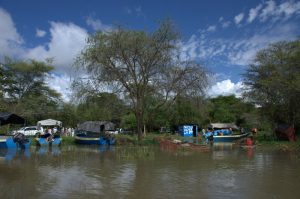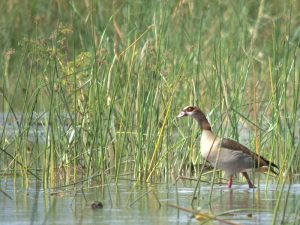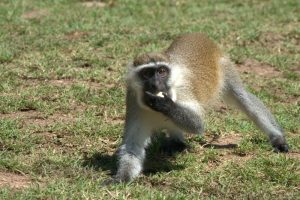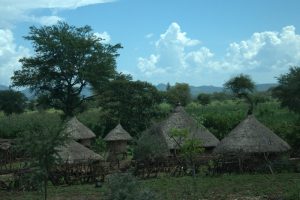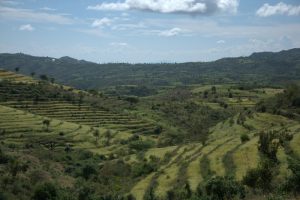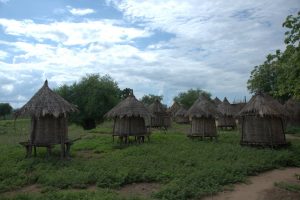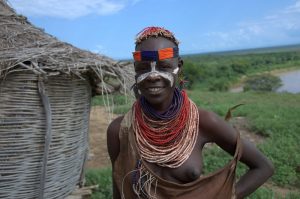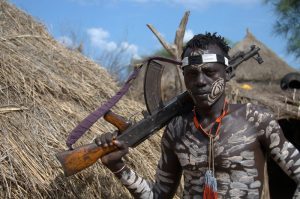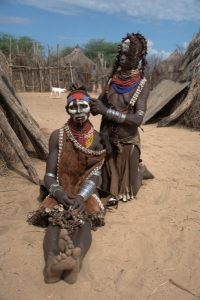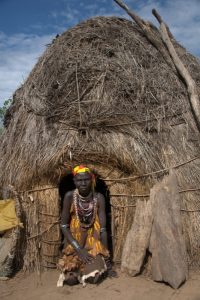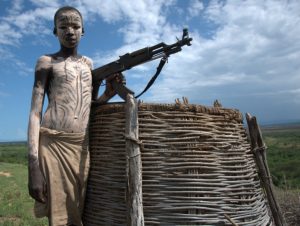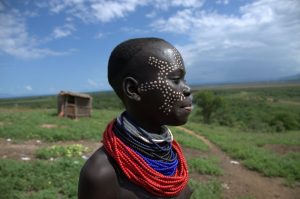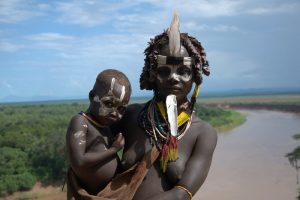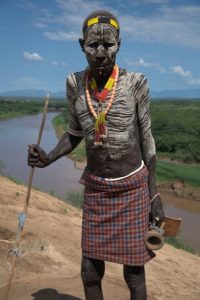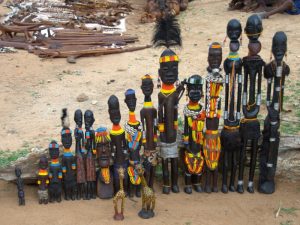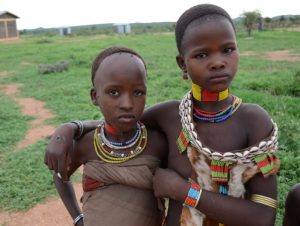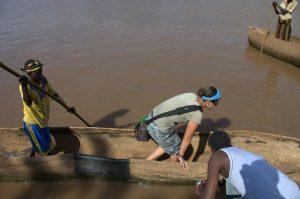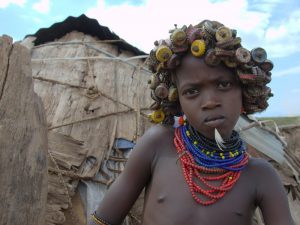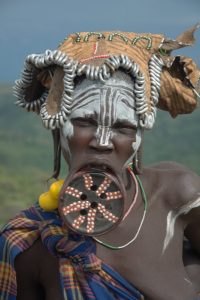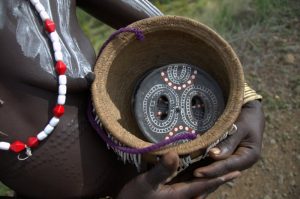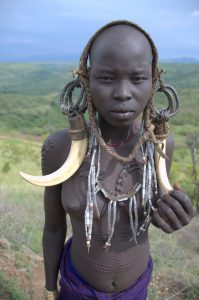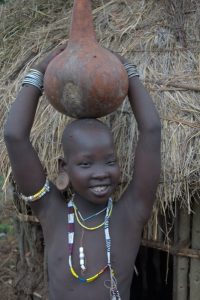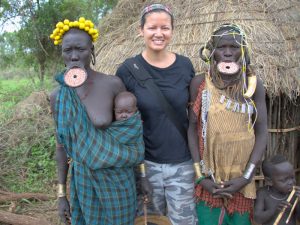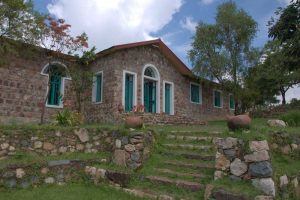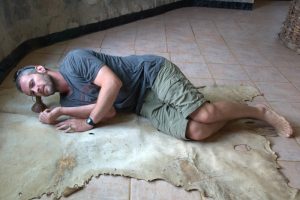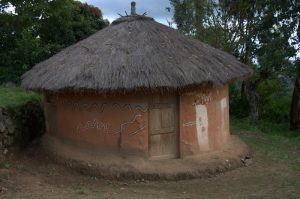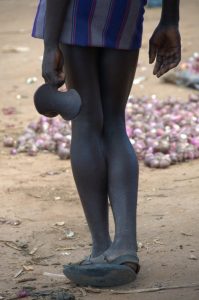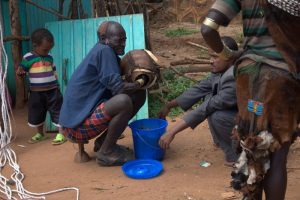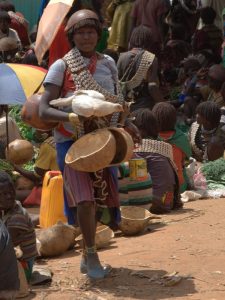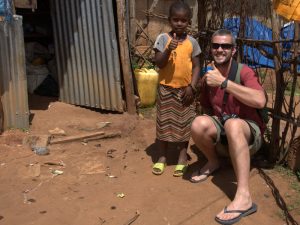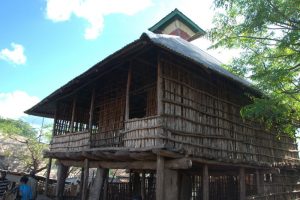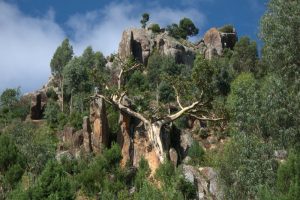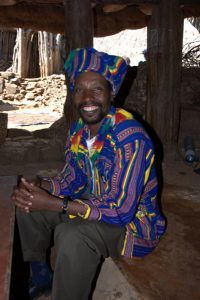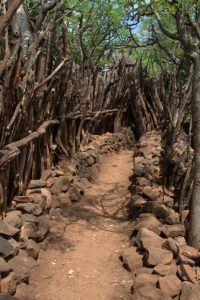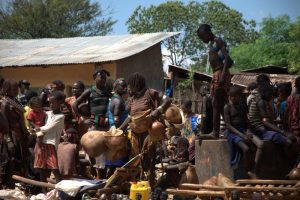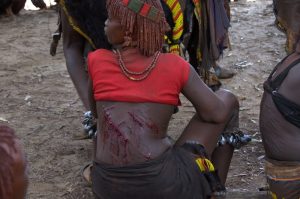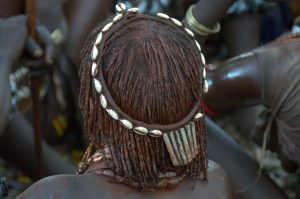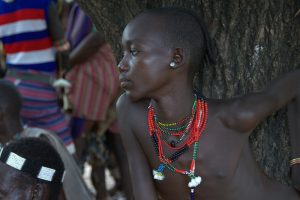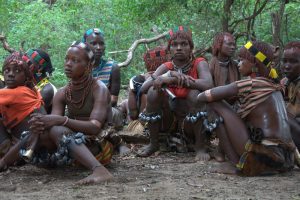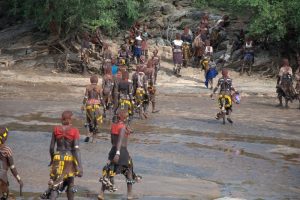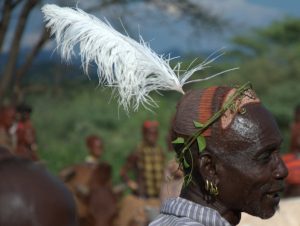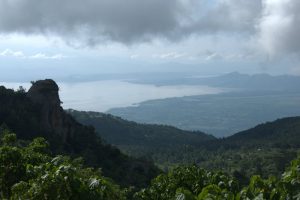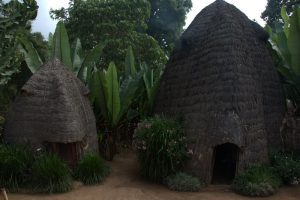Well, we couldn’t stay away from Ethiopia! This incredibly diverse country fascinated us on our first trip here, and we have longed for a repeat visit ever since. Intrigued by other travelers’ ravings about the Danakil Depression (reputedly one of the remotest, most inhospitable, dry and barren regions on earth, with the added distinction of being the hottest place in the world). Yet legions of adventurers pay an astronomical amount of money to visit here. Why? Simply put…it is an exhilarating and pulse-quickening destination boasting the amazing hues of Dallol (a hydrothermal field showcasing the world’s strangest volcanic landscape), the lava lake of Erta Ale (one of 5 lava lakes in the world and the closest one you can get to), the famous salt-laden camel caravans stretching hundreds of beasts deep in formation, and the fearsome Afar tribe who carve their teeth into a v-shape for beauty. We gladly paid a princely sum to see this part of the world for ourselves, and are glad to report that it lives up to its very high expectations. While in Northern Ethiopia, we also managed to add in a day trip to Tigrai to see a sampling of its famous rock hewn churches. The second part of our trip was a journey through the Omo Valley. We have been keen on visiting the tribes of Omo Valley for years now, and feared it was never meant to be as the tribes are quickly assimilating into the rest of society, blending in by donning modern clothing and abandoning their traditions. However, we were glad that we did manage to squeeze in a visit before it is too late. The tribes were utterly fascinating! We hit all three of the region’s biggest markets (Turmi’s Monday market, Key Afar’s Thursday market, and Dimeka’s Saturday market), visited and interacted with the Hamer, Banna, Karo, Dhasanech, Mursi, Konso, and Dorze tribes. The highlight of this portion of our trip was undoubtedly the “Jumping of the Bulls” ceremony (a coming of age ritual where an initiate must jump over the backs of 10-12 bulls/cows lined up in a row several times without falling before he is allowed to marry an eligible bride of his choosing). It was a privilege to watch and neither of us will ever forget what it was like to witness that amazing spectacle first hand.
Hamer women selling greenery at the Turmi market. Notice the woman in the foreground? She is wearing a first wife "bignere" necklace (identifiable by its distinctive iron protrusion which is a phallic and status symbol). We felt sorry for all the Hamer women without the bignere necklace as they are treated poorly by their husbands We were surprised to learn that most Mursi women don't wear their clay lip plates all the time (they are simply too heavy). They insert the plates when they are serving their men sorghum (or coffee or milk). Its a status symbol of beauty to have one as it represents a woman's commitment to her husband. The Mursi (both men and women) look down upon any woman who does not have her lip cut At puberty, Mursi girls have their lower teeth removed (at least 2 and sometimes 4) and their lower lip pierced to insert a lip plug. Once their lip stretches out, the lip plug gets larger and larger until a clay plate can be inserted. The larger the lip plate, the more desirable the woman to a Mursi man. Here, you can clearly see where this girl's lower teeth have been extracted Detail of a Konso waga. Our guidebook informed us that waga are reserved for the grave of an important Konso man or warrior. Each waga will have the somber facial features of the dead warrior, complete with enlarged teeth made from animal bones. Many of the waga near Chief Gezahegne's compound have been looted and our guide told us that very few of these remain to be seen today An Olahita (generation pole) in the village's ceremonial square. You can tell how old a Konso village is by counting the number of poles bound together and multiplying the total by 18. This is because Konso society is structured by a generational set (boys between the ages of 8 - 25), and each village initiates a new generation every 18 years Once the cows are lined up in a row, the naked initiate must leap on the backs of the cows/bulls until he finally reaches the end of the row. This process is repeated four times and it is vital that he not fall down or stumble off the back of a cow. Once he successfully completes this ritual, he will have earned the right to marry






10 Nov 2013: Little did we know but our international flight with Ethiopian Airline (Djibouti – Addis via Dire Dawa) would end up saving us a ton of money. Starting 1 Nov, domestic flights within Ethiopia essentially quadrupled overnight, but were still offered at a steep discount to those who had booked an international flight with Ethiopian Airlines. We were waiting in Djibouti’s tiny airport to board our flight when the check-in clerk came running looking for us. She had forgotten to physically inspect our credit card upon check in (mandatory for Ethiopian airlines). Once she confirmed we had the actual credit card in hand, she breathed a sigh of relief and we were allowed to board our flight. We had a quick stop in Dire Dawa to drop off and pick up several passengers before continuing on our way to Addis Ababa. Upon arrival in Addis, the bizarre visa upon arrival process began. Apparently, even though our flight was technically an international one, we had arrived to the tiny domestic airport (Terminal 1). At the passport control counter, we were advised to stand off to the side to wait to get our visa. We were then informed that we would have to hop on a shuttle to Terminal 2, where there was a visa upon arrival office. However, how and when we could retrieve our checked in luggage remained a mystery…the airport staff was trying their best to rush us onto the shuttle without our luggage (stating we could collect it later) but we stood our ground and demanded to collect our luggage first. In retrospect, this was a good move as we found that after obtaining our Ethiopian visas, we had to exit from Terminal 2 (and wouldn’t have had a chance to return to Terminal 1 to retrieve our bags). Experienced Ethiopian travelers always recommend getting an Ethiopia visa in advance, but we knew it would be far cheaper ($20) to do it upon arrival. Thus, when we were stuck in line for over an hour to get our visas, we simply shrugged and thought about all the money we had saved. A bit of inconvenience was definitely worth the savings! With our 30 day visas in hand, we exchanged a bit of money to have some Birr on us before getting stamped into Ethiopia. From Terminal 2, we had to backtrack to Terminal 1 where we checked in to our domestic flight to Mekele. Becky had coordinated to link up with an Ethio Travel Tours (ETT) representative as he still needed to get paid for booking our domestic flights but no one showed up at the agreed upon meeting spot. It was a bit bizarre as ETT would be out of money since they had already issued us an electronic copy of our domestic tickets. Checking into our flight to Mekele was straightforward and the departure lounge had some nice reclining chairs that we took full advantage of. Our arrival to Mekele was a bit of a shock as the warm weather we had experienced so far disappeared once the sun set. Disappointingly, no one from ETT was at the airport to meet us. It was a sickening feeling as we had emailed beforehand to ensure we would get picked up. Outside in the taxi parking lot, we thought we would be able to negotiate a ride downtown but not a single driver was game. Each one quoted a firm 160 Birr for a one way trip, and one by one, the supply of taxis dwindled as other travelers grabbed their rides. Finally, after wavering between wanting to wait for ETT or risk getting ripped off by paying an overpriced fare, we finally caught the last taxi and had to squeeze in with 2 other paying passengers (to the Axum and Milano hotels). The taxi driver made out like a bandit since he received 3 fares for that one short ride. We were headed to the Atse Yohannis Hotel, which received decent reviews online and in our Bradt guidebook. Surprisingly, the clerk told us that we could book a single room if we wanted (cheaper than a double which was what we thought we had to get). There were two rates, one with breakfast and the other without. Since we thought we were leaving for Danakil tomorrow, we told the clerk that we weren’t sure about breakfast and she assured us we could always book breakfast later and pay the difference. With that verbal assurance, we agreed to get a single room without breakfast and checked into our room, with our first priority to make contact with ETT. Becky remembered reading that the office was “behind” the hotel, so after a short walkabout, we found the office locked down for the night. ETT’s cell phone number was listed, so at least we had a way to get in touch with them. The staff at Atse Yohannis was acting sketchy when we asked if we could borrow their phone to call ETT, but eventually one of the nicer receptionists relented and put us in touch with Abeba (the ETT representative in Mekele). However, she burst our bubble by telling us that no tours were heading to Danakil tomorrow which was highly disturbing as Daniel (the ETT representative based out of Addis) had promised that we would leave tomorrow, 11 Nov). It was a very frustrating hour for us while we waited for Abeba to head back to the hotel so she could brief us on our options for tomorrow. When she finally showed up, Abeba was quite apologetic as she realized we had been given the runaround and were feeling quite annoyed with ETT up to this point. She showed us a text message from Daniel informing her that we were to arrive to Mekele tomorrow and had coordinated an airport pickup. That explained why no one from ETT met us at the airport. Additionally, Abeba told us that the next ETT group trip to Danakil was departing the day after tomorrow (12 Nov) as permits and security escorts had to be organized first. Since it was impossible for us to salvage our current plans, we decided to go with the flow and see what the area around Mekele had to offer. Abeba suggested visiting the churches of Tigray which we readily agreed to. Since it was a full day trip, Abeba recommended that we depart at 8 am tomorrow, giving us plenty of time to enjoy breakfast before departure. However, when we tried to inquire at reception about adding breakfast to our room rate, the clerk was unhelpful and told us that since she had already processed our receipt, it was impossible to modify and we would have to pay full rate at the restaurant (this was totally different than what she had told us upon check-in). Arrrgh, it was a very frustrating first day in Ethiopia. We wearily went to sleep while worrying about modifying the rest of our schedule so that we would be able to squeeze in everything we had originally planned to do.
11 Nov: The night was a bit loud with dogs barking outside incessantly. Also, some kind of motor would start running in the wall of our bathroom and then stop about every hour or so. Thus, neither of us had a restful night! At 7 am, we went down to breakfast. We found that we could have paid 40 Birr with the room rate for breakfast included for both of us. Paying for breakfast separate was 50 Birr each plus taxes, so we ended up spending 121 Birr instead of 40. Oh well, breakfast cost us $6 instead of $2! We met up with Abeba at 8 am and were informed that we would visit some local rock hewn churches in Tigray. The price for our full day excursion would run us $160 for the guide, vehicle and driver, but we would pay for everything else ourselves or $200 for everything included. We opted for cheap option. The plan was to drive to visit a couple of churches that require some challenging hiking and visit some easier ones if time allowed or if we opted for a less challenging day. We were on our way and stopped a little before 10 am at a midway point so that the driver and guide could have breakfast and we could have coffee & tea. We went to a nice little traditional style café that had grass on the floor and smoke in the air to have a drink while the guys ate. The lady making the coffee had Asian features so our guide asked her about her ethnicity. We learned that she has a Chinese father and Ethiopian mother, hence the very interesting and beautiful mix. Our tea, coffee and three 1.2 liter bottles of water ran us 37 Birr. From here, we drove onward to the village of Megab in the Gheralta Mountains to hire a local guide to escort us to the churches (mandatory to hire a guide). The first church we visited was Abuna Yemata Guh. Getting there involved a steep challenging hike up a mountainside and then we had to climb a rock face. Luckily there were local guys waiting to help those who have trouble climbing. Becky was quite pleased to have the assistance, as it was a tough climb up the rock face, especially if you don’t know where the foot and hand holds are. The church had a small collection of human bones just outside in an etched away small room in the rock. People used to bring the dead up there for an “open burial” but they no longer do this. There was also a niche carved into the rock where mothers would bring their babies to be baptized. The inside of Abuna Yemata Guh had incredible frescos, probably the best we’ve seen so far in Ethiopia. After having as much time there as we wanted, we were ready for the return trip. Thankfully, the climb down was much easier. As we descended we saw some other visitors struggling up the cliff face. They hired guides with ropes to hoist them up so that the ‘climb’ was much easier for them. One of the elderly ladies was hyperventilating on a ledge near the top, probably due to her nerves. We were sympathetic as a visit to this church is not one to be taken lightly! When we finally reached the base of the mountain, we decided that one climb was enough for the day and decided to visit two other popular churches that are close to the road and easy to get to. So, our second church of the day was Abreha we Atsbeha, which is considered by some to be the finest rock hewn church in Tigray. It had nice paintings and an Italian portico that was added to the front. Well worth a visit. If we had known that the last church, Wukro Chirkos, had been destroyed by fire by Muslim leader Ahmed Gragn in the 15th century, we both would have agreed to give it a miss. This was the least impressive church of the day, as almost none of the paintings had survived, and the damage to the church itself was intense. By now we were all churched out, so we decided to head back to Mekele. First, we had to make a quick detour to a bank to exchange some money. Back at the Atse Yohannis Hotel, we stopped by the reception to extend our stay for another night. Becky specifically requested that breakfast be included in our second night’s stay but the receptionist forgot as she rang up our bill and then refused to modify it, stating that once the receipt is printed, it automatically gets sent to the government and cannot be modified in any way, shape or form. Robby was pissed and wanted another form of compensation but she refused to help, stating there was nothing she could do other than apologize for making a mistake. We were both perturbed but had no recourse so we went upstairs to grab our room key and went directly to the restaurant for dinner. Robby tried a St George’s Amber beer and lamb tibs, while Becky opted for a safer roasted lamb and chips. Dinner was plentiful and tasty for $12. After dinner we checked email and discovered that ETT had modified our Ethiopian airlines flights, giving us 2 less days in the Omo Valley than desired. We were not happy with the change so we emailed an alternative suggestion and it looked like ETT agreed to it. Becky later got an email advising her to go directly to the Ethiopian airlines office in Mekele to work it out with them directly, with the advice that we should purchase a flight from Arba Minch to Addis on our own. We were expecting to see Abeba tonight but she never came by. So far we have had no luck paying for anything with ETT (for the Danakil tour, for our domestic flights, for our day trip). They are a most peculiar company, relying heavily on good faith with their customers. So far we have scored a free flight and day trip through ETT!
12 Nov: We had to get up early to have breakfast before heading out to the Mekele based Ethiopian airlines office to modify our domestic flights. Our Bradt guidebook indicated that the office was right around the corner from us, but it has since been relocated halfway across town and required a significant hike to get there. Our Danakil Depression tour was set to leave around 10:30 am, so we didn’t have much time to sort out our tickets, and to our dismay, we discovered a long line at the Ethiopian airlines office. However, the strict security guard was keeping the queue in check, and customers were being briskly assisted so it wasn’t a super long wait before it was our turn to sort out our tickets. We had anticipated being charged for the new flight from Arba Minch to Addis, but the helpful assistant was able to modify our original flight (Addis – Arba Minch) for a simple change fee…bonus! And since we had booked it prior to 1 Nov, we scored it at the cheap domestic flight rate. Flights being booked after 1 Nov were about triple/quadruple the price that we paid. After paying for the change fee downstairs at the bank, we brought proof of our receipt back up to the airlines office where our new tickets were issued. All sorted out in under an hour…awesome! We still didn’t have much time to spare as we still needed to sort out what to bring with us to Danakil and what to leave behind, so we hopped in a tuk tuk for the drive back to the hotel, saving ourselves about 20 minutes of walking in the sun. Back at the hotel, we had to rearrange what to bring out to Danakil. Other travelers reported the rim of the Erta Ale volcano to be quite windy and cold, so we brought a jacket, fleece sleeping bag liners, and gloves/hat in case the weather was a bit too chilly for our liking. Our big bags were stored at the reception of the hotel, and we settled payment with Abeba prior to the expedition leaving ($500 each for the Danakil tour and $160 for the Tigray church tour). $500 is the cheapest price we could find with a reputable company, and ETT had numerous positive review on LP Thorntree so we opted to go with them. Everyone had reported that while $500 is a princely sum to pay for a short 4 day trip, it was money well spent as this is one of the remotest regions of the world to visit. Our group consisted of a convoy of 6 vehicles, and we were assigned to vehicle #6 along with Andreas (German) and Fiona (French). Our driver was a pleasant guy named Yamani, and the tour leader for our 20+ group was a personable young man named Ngassi. We quickly got to know some of our fellow travelers as everyone was quite excited about visiting Danakil. Cat is a doctor from the UK, Mickey is a feminist world traveler from the Netherlands. Our trio of Germans consisted of Andreas, Frank and Jutta (she works for the DOD at Landstuhl). Two Israelis were Shahar and Erez. A tightknit group of four from Catalonia, Spain along with another group of four Russians rounded out our international group. We looked enviously at some of the other 4x4s in our convoy, but soon saw that they filled up on the journey as other passengers were joining us later in the day. Today’s goal was a drive from Mekele to Hamed Ela, which we had been told would take about 6 hours. We left Mekele a little after 11 am and after driving for a couple of hours, pulled over for a lunch stop. There, we enjoyed a pasta lunch under the shade of a couple of trees. Several Afar children crowded around to watch as we ate, and some of other tourists wanted to take their picture. However, a young Afar boy became extremely agitated and picked up a stone, threatening to throw it at the offending camera holder, causing Ngasii to intervene as peacemaker. He explained that many of the Afar people do not want their photos taken, and urged everyone to be aware of the cultural sensitivities. Crisis averted, we drove onward towards the town of Berhale, where we got out to stretch our legs and examine this gateway town into the Danakil Depression. Countless camel caravans either transit or terminate in this town, making for a scenic stop. Robby struck a pose on an old tank before the colorful Afar women at the well caught our attention. To our surprise, none of them minded us taking photos and we hung out with them until incoming camel caravans forced us to tear our attention away. The Afar men leading their camel caravans had broad smiles on their faces as they neared Berhale. For many of them, this oasis rest stop was a chance to drink some water, take a well-deserved shower, and most importantly, sell and cash in the salt blocks they had been transporting for several days. Some chose to continue onward to Mekele (their salt blocks could bring in double the price there), but most opted to rest their weary camels at Berhale. We were fascinated by this age old tradition of salt harvesting, transport and trading, and couldn’t believe that the Afar still voluntarily choose this harsh lifestyle to support themselves and their families. In Berhale, we picked up several more passengers and once our security escort was sorted, we continued on the final push towards Hamed Ela. Camel caravans soon started dotting the landscape quite frequently, and camel crazy Andreas didn’t hesitate for a second to ask Yamani to stop for photos. Yamani graciously obliged, and all of us took many a camel caravan photo that afternoon. Our open air campsite at Hamed Ela had comfortable cots, a cool breeze, and a complete lack of privacy. What else could we ask for? Ngassi pointed to the great wide open and proclaimed, “the world is your toilet”. Nice. We strolled around the village of Hamed Ela, watching as several camel caravans pulled in to rest for the night. Dinner was a buffet style spread which was ravenously consumed by the group. We quickly learned not to hesitate around anyone on this trip or else we’d end up going hungry. The Russian group brought out a spotlight, techno music, vodka and Ethiopian wine and started a mini party. Stereotypical Russians…they sure like their liquor! The group of Russians consisted of two guys and two girls. The guys happened to be quite overweight, while the girls were extremely petite. Over dinner, the girls were serving their men the food first and acting quite subservient. After dinner, we watched as the guys ordered their women to dance for their entertainment along with the strobe lights and alcohol. It was quite bizarre and the rest of the group observed in a state of shock and ridicule. Who knows what the locals of Hamed Ela thought of the impromptu party? We were glad when they finally pulled their cots away from the rest of the group to continue their revelry.
13 & 14 Nov: Since Fiona hogged the front seat all day yesterday and she had every intention of doing so again today, Becky had a little talk with her. End result was a rotation schedule. With Becky claiming the front seat today, we drove out to the nearby Asale Lake to see the Afar salt mining operation. Originally scheduled for later in our tour, Ngassi realized that the workers would be resting on that day (Friday), so he bumped up our visit so we wouldn’t miss out. We were very glad for the change as the entire salt mining area was fascinating and it would have been a real shame to miss. The Afar men working this area are very tough individuals! You’d have to be working under scorching conditions with no shade, no fresh water source other than what you carried in, and blinding white salt surrounding you for as far as the eye can see. Many of the Afar men had shaved their front teeth into a v-shape, which made for interesting portraits. Surprisingly, the men were quite willing to pose for photos, but many of them continued to work while we snapped away. The men work from dawn till dusk chipping away blocks of salt into identically sized bricks, which are then bundled up and loaded onto the awaiting camels before a trek back towards civilization. We spent about an hour at Asale Lake before reluctantly loading back up into our 4x4s for the long drive out to Erta Ale. ETT had warned us that today’s roads might be the worst on earth, taking us 6 hours to traverse 80 km. However, we didn’t find it to be too bad. At one point, Yamani got our vehicle stuck in a sandy spot, but it didn’t take long to dig us out and get us back up and running. Our lunch stop was at a place we nicknamed the “sauna box”…needless to say, it was very hot! We were sweating more liquids than we were consuming, negating the need for pee stops. After lunch, we pulled up to a military camp where two other tour groups were sitting in the shade, patiently waiting for their military escorts. Ever since the January 2012 incident where 5 European tourists were murdered near Erta Ale, the Ethiopian government has made it mandatory for military escorts to accompany every single tour group to this area. From the military camp to the base of the volcano, we had to traverse some of the most difficult terrain (jagged volcanic black rock) on the journey so far. Amazingly, not a single vehicle in our convoy had a flat tire! By 3 pm, we reached the makeshift campsite at the base of the volcano. Ngassi told us to rest for a few hours before an early dinner. After that, he said we would immediately hike up the volcano once the sun set (around 6:25 pm). By 6:30 pm, we were on the move once again, trudging up the volcano. The hike wasn’t too bad as it gently slopes up to the summit of the volcano. We took breaks every 50 minutes and before we knew it, the night view of the volcano was in the distance. It was a bit of a sweaty affair hiking up for 3 hours, but well worth it. The view was spectacular…absolutely mesmerizing. We learned that there are only 5 volcanic lava lakes in the world (Guatemala, Antarctica, Hawaii, Ethiopia, Congo), but Erta Ale in Ethiopia is the one you can get closest to. We were amazed that we could get to within meters of the edge of the lava lake. Our guides were cautioning everyone not to get too close as a fall into the rim would definitely be fatal. Everyone was happily snapping photos, although it was quite hard to capture the aura of the majestic site without personally experiencing it. Just before midnight, we were ready to call it quits, so we set up our camp site for the night (mattresses provided courtesy of ETT and lugged up via camel). It was a peaceful, open air campsite. Until several drunk tourists started chatting loudly at 2 am. Still, we slept quite well until our 5:15 am wakeup shove from Ngassi. While the view of Erta Ale at night is unforgettable, a sunrise view is just as memorable as it allowed us to experience the lava lake in different light. Very very cool. Everyone kept raving about how this was so worth the long, arduous journey. We hiked up a small hill overlooking the volcanic crater, which was pretty cool as it gave us a greater appreciation for just how massive the crater is. After that, Ngassi led us over to a nearby “dead” volcano which was quite colorful. From here, we grabbed several oranges to fuel us on the downward hike back to base camp. Interestingly, one of the other groups we ran into yesterday had already descended at about 3 am, missing the sunrise over Erta Ale. We can certainly attest that they missed out big time! Why on earth would you come all the way here and leave before the best part? The hike down the volcano took us about 2 hours and when we reached the base camp at 11 am, breakfast was spread out before us. We decided to take a quick water bottle shower in one of the empty Afar huts, but a few minutes after rinsing off, we were both sweating again (and this is during the “coldest” time of the year to visit Danakil…imagine visiting in the middle of the summer!) Afterwards, we had a long drive back to Hamad Ela with Robby sitting in the front seat. It was a very bumpy return trip and we were jostled, bumped, smashed and crowded while trying to sneak a nap in. At 3:15 pm, we stopped for a late lunch beneath a shady palm tree. Here, we had a snake like lizard visit us for some food. It had no fear as it came up to us, eagerly devouring the pasta bits we threw to it. It especially liked pasta with tomato sauce. Somehow we suspect this lizard has been exposed to humans eating lunch before. Thankfully, we only had another 45 minute drive from the lunch stop back to Hamed Ela. Here we stretched out our legs while Ngassi tried to get permission for us to revisit Lake Asale for sunset. It took thirty minutes before the military escorts gave us the green light, so we all eagerly loaded back into our vehicles for the short 20 minute drive to the lake. Yamani asked Becky if she was interested in riding on the roof and she readily agreed, setting off a chain reaction as passengers from the other vehicles followed suit. Fiona attempted to ride on the roof but soon started hyperventilating. After almost passing out, she decided to retreat to the inside of the vehicle, claiming that she couldn’t breathe clean air from the roof. Watching the sun set from Lake Asale was cool. We took a couple of silly photos before the last rays of sun faded. Back at the camp, a group of us decided to find cold beer to celebrate Robby’s birthday. Rumor had it that the Ethiopian army camp in Hamed Ela had a coveted generator, which powered a TV and refrigerator. We were quite happy when the rumor proved to be true as all of us scored cold St George’s beer at a reasonable 20 Birr each. Andreas toasted Robby’s birthday and everyone cheered at his luck in visiting one of the world’s most incredible natural sights (Erta Ale) and scoring a cold beer while in the middle of the Danakil Depression. Some people get all the luck! To top it off, our chef had prepared a freshly slaughtered goat for dinner, serving up roasted goat that was a hit with all the carnivores. We laughed as we watched how Ethiopians devour meat. The Japanese girl on our trip kept bringing over bowlfuls of goat meat to our drivers/guides and breaking down in a fit of laughter at watching how aggressive everyone was in tackling the meat from each other. It was truly hilarious to watch! Everyone was asleep on a cot by 10 pm. Even the Russians who appeared to be tuckered out after the hike up and down the mountain.
15 Nov: The chef was busy preparing breakfast at the crack of dawn and we were up soon afterwards (5:30 am). This morning’s quest was to find a private spot to take care of business in the great wide open…not an easy feat! Breakfast was at 6:30 sharp and latecomers had to make do with the leftover morsels. The chunky Russian men were always prompt and never failed to get a hefty portion of food first. Today was the last day of our Danakil tour and we were to visit Dallol before the drive back to Mekele. Ngassi advised everyone to wear shoes (in lieu of flipflops) for wandering around Dallol. Also, he recommended that each of us lug an extra bottle of water, as well as a heavy application of sunscreen. Dallol is a geological wonder. We had seen photos of it beforehand but nothing adequately prepares you for it. Located 130 meters below sea level, Dallol is famous for being holding the hottest average year round temperature (96 degrees Fahrenheit). It is a volcanic crater that is constantly morphing, with hot springs spewing brine and other acidic liquids here. We can attest to the many birds that swooped in for a drink and met their fate here. The entire area is a massive salt plain, and there were plenty of geysers building up domes of salt. Dallol is quite colorful, with hues of yellow, orange, red, black, grey and green catching our eye. Needless to say, we took a ton of photos here, and Ngassi finally had to herd everyone up to leave when he realized we wouldn’t willingly leave on our own. Our second stop was at the incredible Salt Mountain, located a few hundred meters from Dallol. This entire “complex” is built out of salt! We slithered through tunnels, clambered around salt mounds and were wary of the super sharp salt formations that appeared to be as jagged as the edge of a knife! Some of the formations could easily slice you open, so we paid close attention to our surroundings. After Salt Mountain, we drove over to “Oily Lake”, so nicknamed as it is a potassium lake with what looks like an oily surface. This lake is popular with the local Afar people who fill their water bottles up with its liquid to later spread on their skin as a natural ointment. We saw way too many birds who mistook the potassium lake as a viable water source, only to meet their demise here. The Spanish guys tried to show off a human stack but Ngassi wasn’t having any of it, fearing for their safety if they were to plunge headfirst into the potassium pool. From Oily Lake, we headed back to Hamed Ela for one last lunch stop (pasta, beans, sweet potatoes & salad). Our chef definitely did his best to make our food varied and palatable to the different nationalities on our tour. After lunch, we piled back into our vehicle for the long drive back to Mekele. Andreas rotated to the front seat and was quite happy taking photos of the passing scenery. Since we had an evening flight later today, we were hoping to have a couple of spare hours in Mekele to freshen up before our onward trip to Addis. We asked several people in our group if they were interested in a group tip, since all of the ETT staff were well deserving of some recognition and reward. After getting several halfhearted commitments that appeared to be going nowhere, we decided to take care of our driver, Yamani, since he did a fabulous job for us. Hopefully the other drivers were taken care of by their passengers! Ngassi disappeared before we had a chance to thank him for a wonderful trip. Overall, we were very pleased with ETT who did a phenomenal job putting together an mind-blowing tour at a rock bottom price. We can easily see why ETT is the #1 recommended Danakil Depression agency on the various travel forums. After retrieving our big bags from storage and rearranging our belongings, Kat graciously offered her room’s shower for us to clean up before our flight. Washing away all the dirt and grime felt heavenly, and we profusely thanked Kat for her kindness before hopping in our ride to the airport. Little did we know but our flight had actually been bumped up by 30 minutes, so we were the last 2 passengers to be checked in! Good thing we got to the airport a bit early. We arrived at Addis airport and after a bit of confusion, found the ETT representative, Mr Bisrat, waiting for us in the parking lot. He suggested a budget Addis hotel for the night, Henok Pension, which was 330 Birr. Robby went to check it out and reported back that it met all our requirements (hot water, electrical outlet to recharge our batteries, and super clean). After making arrangements to link up with Bisrat in the morning, we did a bit of laundry before calling it a night. The second half of our Ethiopia trip (Omo Valley, on our “to do” list for almost a decade now) was coming up, and we were both excited.
16 Nov: We were up early in search of breakfast before our 8 am meeting with Bisrat. Luckily, the main street just around the corner from our guesthouse had several restaurants, and we found a nice coffee bar to have a breakfast of scrambled eggs and bread. Bisrat was waiting for us when we returned, but he begged off after a few minutes by saying he had some errands to run and would come back to pick us up. This gave us an excuse to pack our laundry which had ample time to dry during the night on the clothesline. When Bisrat finally returned, a hitchhiker was in the front seat. We were on a mission to exchange some money for brand new, smaller bills (1, 5 and 10 Birr notes) for the photography fees in Omo Valley. Other tourists had advised that some of the tribe members were super picky on accepting old, dirty or torn notes and were quite insistent on clean, new notes. A couple of banks refused to assist until we found one that was willing to issue a pack of 1000 brand new 1 Birr notes. It was impossible to get new 5 and 10 Birr notes but we did get a bunch of them and sorted them out from best to worst condition (spending the worst notes in bars and restaurants as they never refuse money!). Excitement was in the air today in Addis as a huge football match (Ethiopia vs Nigeria) was scheduled for later this afternoon. Bisrat surprised us by buying 2 football jerseys as a gift, which we wore with pride. This elicited enthusiastic reactions from the locals who were thrilled to see two Farangi wearing Ethiopian jerseys. Eventually, we met our driver for the upcoming week, a nice guy named Abenezer. Bisrat asked if we minded driving over to the Sheraton so Abenezer could drop off something important before our drive to Arba Minch and we agreed as we didn’t want to start our trip off on the wrong foot. Before departing, we finally had a sit-down with Bisrat and settled our mounting bill. We had estimated our costs of the domestic flights to be $450 ($160 each for a round trip from Addis – Mekele, $65 each for one way from Arba Minch – Addis) and our car hire/driver/fuel to be $1600 ($160 per day x 10 days in Omo Valley). It was only after we paid that Bisrat started mumbling some nonsense about the fact that we wouldn’t need a vehicle for the last day (day 10) of our tour as we were flying back to Addis. He mentioned hiring a private minivan to take us around. When we didn’t commit, he then started suggesting that we could squeeze everything in the Omo Valley in 7 days and still have enough time to drive back up to Addis, forgoing the domestic flight that we had already paid for! We weren’t even taking his halfhearted suggestions seriously as we had already paid for services that we expected to be rendered. We both thought it was idiotic to try to change our itinerary at the last minute to suit Bisrat’s agenda. Later we would find out that we should have been more firm in our discussions, as Abenezer informed us that he was an independent contractor and had only been hired for 9 days total. But, there is more to follow on that later. Driving in Addis is a bit chaotic. Abenezer’s slight detour to the Sheraton set us back by an hour…we hadn’t realized how far away it was from our departure point. However, finally by midday, we were on our way! About 2 hours out of Addis, Abenezer pulled over at a popular rest stop for lunch. It appeared that every single other Farangi tourist heading south to Arba Minch had also stopped here for lunch! The food was good and reasonably priced, and the toilets were clean so who were we to complain? From here, it was a long, scenic drive down to Arba Minch. We saw lots of circular, wooden/clay huts which caught our eye but were driving way too fast to take any decent photos. Closer to Arba Minch, cattle overtook the road and our speed decreased significantly. Abenezer pointed out Lake Abaya in the distance and said we would get to our destination soon. Driving on the road was quite challenging with our constant maneuvering around cows and goats, with many refusing to budge out of the way. It was dark by the time we reached Arba Minch and Abenezer was curious if we had booked a hotel for the night? We told him we were extremely flexible, but wanted a room with hot water and power. After several phone calls to determine that our first choice hotels were fully booked, we settled on the Tourist Hotel (396 Birr) which came with hot water, Wi-Fi, and a massive room. The football match was ongoing when we checked in, and a crowd had gathered at the bar. Robby had a beer delivered to the room while we watched as Nigeria bested Ethiopia 2-0. That night, we heard the faint squeaks of a rat/mouse as it frantically ran around our room trying to chew through plastic bags. The only thing it got to nibble on was a bit of toilet paper and baby wipes! It was a bit off putting and we realized that we should leave our main bags in the car from now on and simply carry a change of clothes and toiletries for each overnight stay to prevent our belongings from being rifled through by a mouse.
17 Nov: First order of business this morning was to hit an ATM to draw sufficient funds for the duration of our trip. We had enough US $ but wanted Ethiopian Birr as we read that banks would be limited in the Omo Valley. Just across from our hotel, we found an ATM so it took no time at all to accomplish our mission. Breakfast of eggs and bread was held in the garden, along with some fresh squeezed mango juice. With our bags packed, we were ready to go when Abenezer showed up. This morning we had opted to visit the Lake Chamo “crocodile market”, which was listed as a highlight in one of our guidebooks. Since Lake Chamo is considered part of Nechisar Park, we had to first go to the park entrance to purchase two tickets (90 Birr each plus an additional 20 Birr for our car). Then we had to drive to another office to arrange for a boat and guide tour. The price listed was per boat, regardless of how many passengers there were. It ended up being a rip off 990 Birr (for boat, guide and boatman) plus an additional 70 Birr for their return trip back to Arba Minch as we were continuing onward to the Omo Valley. Since we were responsible for their return transport back to town, we figured giving them a bit extra for a bus ride made sense. There were quite a few tourists already at the loading area of Lake Chamo, waiting to board their boats. It was obvious that the “crocodile market” is a big tourist draw in this area. We loaded up into our boat and wore the life vests (mandatory) while our boatman guided us out into the lake. Our 90 minute ride introduced us to African fish eagles, pelicans, storks, and some ducks. We saw a pod of hippos along with several crocodiles sunning themselves. Perhaps we are a bit jaded after seeing some spectacular wildlife in Botswana, but Lake Chamo did not impress, especially after our guidebook had hyped it up so much. We had expected to see hundreds of crocodiles, not a dozen or so! Overall, we would have given this a miss if we had known what to expect. It certainly wasn’t worth the expense in our minds. However, some of other tourists on the other boats were yelling in excitement at each crocodile, so maybe they felt like they got their money’s worth? Needless to say, neither our guide or our boatman received an extra “tip” for their services , and we were glad to leave Arba Minch behind as we drove south to Turmi. We didn’t get very far before we ran into a bit of a commotion on the road. A bus had run out of gas, and it was occupying both lanes of a makeshift bridge. Since this was the only way to cross the river, traffic was backed up on both sides. The driver was refusing to budge until a collection was gathered to give him enough money to buy more fuel. It was the most ridiculous scenario…the passengers on the bus had already paid their fare and they didn’t feel responsible to pay more for fuel. All other inconvenienced travelers (ourselves included) didn’t feel like we should be held hostage to the driver’s ludicrous demands. A nasty scene was brewing on the bridge as some of the more aggressive (and fed up) drivers insisted that the bus driver move his vehicle out of the way to allow traffic to continue. Eventually, the driver was convinced (either through money or might) as he grudgingly moved his bus off the bridge. During the standoff, Abenezer told us that we might have a problem with our itinerary as he had been instructed to drive back to Addis on Day 9 of our 10 day tour. Since we paid for a full 10 days with private car/driver, we refused to budge but obviously had to de-conflict the situation with Bisrat. Our first phone call was abruptly hung up on, and we followed up with text messages telling him flat out that we refused to alter our originally planned (and paid for) itinerary. After several back and forth texts, we finally got a one word answer from Bisrat, stating “OK”. Little victories! We let Bisrat explain the new situation to Abenezer and breathed a sigh of relief that this sudden suggestion of a change in plans was finally over. After a few hours on the road, we stopped at Karat-Konso to have lunch at the impressive Kanta Lodge. Our meal (goulash) was reasonably priced, and it seemed that every single tourist headed to the Omo Valley stopped here for lunch as well. Kanta Lodge certainly appears to be well established on the tourist trail, perhaps because of its affordable meals, clean bathrooms, and impressive views? The lodge itself seemed to be a popular place to overnight in Konso with its tukul style buildings (complete with thatched roofs crowned by clay pots). From Konso, we drove onward to Turmi. Konso is a UNESCO world heritage village famous for its terraced hills. We admired the cultivated hills as we zoomed on by. The other thing that caught our attention here were the skirts that every Konso woman wears (traditional hand loomed skirts with a colorful flounce around the waist). Once we crossed the Weito River, the temperature started rising. From Weita, there are two routes leading to Turmi. We assumed we would drive south towards Arbore, but Abenezer was reluctant as he said it would require a river crossing. If the river was too high (quite common during rainy season), we would have to double back to take the northern route to Turmi. So we opted for the longer route to Turmi, heading north towards Key Afer and then south past Dimeka before finally reaching Turmi. We had expressed our deep desire to see a Hamer bull jumping ceremony and Abenezer said he would make inquiries once we reached Turmi. We didn’t get there until late afternoon when we pulled into Turmi Lodge. Set on the outskirts of Turmi, this scenic lodge offered camping as a budget alternative to a room. We decided to go with the tent option, which was quite nice. A huge 4 person tent was erected in mere minutes, and mattresses with linen were provided for us. This ran us 360 Birr for the night (about $19) and the lodge came complete with a bar, restaurant and limited electricity (after sunset for a few hours). Abenezer promised that he would head directly to the tourist office to find out about the bull jumping opportunities and we agreed to link up the next morning and organize our itinerary based on what he was able to find out. Dinner at the lodge was a buffet with a reasonable spread of beef, pork, potatoes, rice and salad, topped off with bananas for desert. It was OK but we would have been equally happy ordering off the menu. That option wasn’t offered to us the first night, but we saw another couple who had ordered off the menu an hour before the buffet was spread out so we kept that in the back of our minds for tomorrow. Our showers were cold water so we both made them brisk. The tent was quite comfortable as the day had cooled rapidly after sunset and our thick covers were quite appreciated. It was a peaceful night’s sleep for our first night in Hamer territory.
18 Nov: After a restful night’s sleep, we were up early. Our camping accommodations in Turmi were unexpectedly good! By 7 am, we headed over to the restaurant area for breakfast which consisted of oatmeal, undercooked pancakes, sliced boiled eggs, fried dough balls, sliced bread, tea and a nice orange/banana juice mix. The laundry we had washed and hung on our line the night before was still damp so we made the decision to leave it out to dry all day. Abenezer showed up promptly at 8 am with the news that we had missed a bull jumping ceremony yesterday in Dimeka. Gutted! We really wanted to see one of those and were a bit perturbed that we probably wouldn’t have another opportunity while in the Omo Valley. This morning, we were to drive out to Kolcho Village to see the smallest of the Omo tribes, the Karo tribe (their numbers have dwindled to about 1500 tribe members). Famous for their body paint, the Karo tribe is an “easy” introduction for tourists as they are not as aggressive as some of the other tribes in demanding photos. Kolcho Village is one of the most popular stops for tourists as it commands a high vantage point overlooking the Omo River, making for a scenic backdrop. The drive took about two hours, and along the way, we stopped for a photo next to the “Burj Khalifa” of termite hills. A Hamer boy was strolling past with his cattle, and he curiously watched as we took photos next to the termite mound (probably thinking tourists are a bit crazy!). Robby had devised a way to strap a GoPro to his backpack as an inconspicuous way of recording our village visits and he got to try out his contraption for the first time at Kolcho Village. Thankfully, our guidebook was correct in predicting that the Karo would be mellower than other tribes at demanding photos, and we appreciated this as it was a gentle ease into the sometimes uncomfortable territory of taking portraits of strangers. The going rate per individual was from 2 – 3 Birr, although some of the “models” would want 5 Birr if they posed for an extra long time or saw that we were taking multiple photos. Unlike what we were led to believe, they weren’t counting each click of our camera! We were grateful for our new, clean 1 Birr notes as it made it quite easy to settle the camera fees. The cost to visit Kolcho came out to 550 Birr (vehicle, guide and entrance fees paid directly to a village representative). Even though we had only taken photos of about 10 villagers each, we felt that a visit here was worthwhile. The sky was threatening to downpour with rain, and Abenezer was fretting that we wouldn’t be able to make the river crossing in time before it became flooded. Luckily, we made it in time but the other tourists who were just pulling up to Kolcho as we were leaving probably weren’t as fortunate. Abenezer explained that once the river bed filled up with water, it was a waiting game as none of the drivers were willing to attempt a river crossing as lives has been lost in the past during such attempts. After crossing the river bank, the rain came down torrentially. We were a bit concerned as this afternoon we had planned on visiting the Turmi Monday market (one of the best in the region), and Abenezer thought that many of the Hamer who normally visit the market would stay home because of the rain. However, by the time we finally reached Turmi, the rain had subsided. Abenezer recommended that we visit the market before lunch, and we agreed. Since this was our first market visit in the Omo Valley, we thought it was pretty spectacular. Tourists were driven away because of the rain, and the market itself was full of Hamer and Bashada tribe members. Abenezer said that the market was not as busy as it usually was, but that didn’t deter us any. We each went our separate ways to explore and for some reason, Robby ended up with a local “guide” who latched on to him the entire time. Meanwhile, Becky was having a blast taking photos on her own, awestruck by the beautiful Hamer women and the colorful market scenes. Truly brilliant! We linked up again after 45 minutes and showed each other our favorite sections of the market. Robby’s guide was trying to convince him to buy him a dictionary for 250 Birr (does that scam work on anyone?), but in the end accepted a tip of 40 Birr for his services rendered. Back at Turmi Lodge, we had lunch of steak sandwiches which were pretty tasty. On the menu, we discovered the nasty surprise of the inflated prices we were being charged for the buffet breakfast and dinner (we had no say in the matter when first offered the buffet as our dining option), so after the sticker shock, we were determined to order off the menu for our remaining meals. Since the only other thing we had planned for later that afternoon was a visit to a nearby Hamer village, we rested until 4 pm, when Abenezer returned with a local Hamer guide to escort us in the village. Poor Abenezer had been busy since he dropped us off for lunch. Our 4×4 had a flat tire that Abenezer had spent several hours dealing with but that was all sorted out before our afternoon excursion. The visit to the Hamer village (400 Birr total – 200 Birr local guide and 100 Birr each village fee) was a bit anticlimactic after the Turmi market today. We saw the Hamer in a natural environment at the market, and the village visit felt way too posed. Plus there were throngs of tourists in the village, and the tribe was competing for their photographs. It really did feel like a human zoo and we tried our best to walk around avoiding the other tour groups. Our Hamer guide actually didn’t hail from this village, and we wondered how that would affect our tour as the guides are supposed to be from the village we are visiting. Our worries were founded as an ugly scene unfolded before our very eyes. Unbeknownst to our guide, Robby had taken a photo of a baby camel that the Ethiopian government had given to the village. This was a harmless act…we were told to negotiate photography fees beforehand of any people, but animals? Come on! The owner of the camel was demanding compensation, but our guide was defending Robby furiously, stating that he had only taken photos of the Hamer children who had been following us around. We had no idea what the fight was about as they were both angrily arguing in Hamer. We were caught in the middle as it soon became apparent that we were no longer welcome in the village. Bewildered at the quick deterioration in the situation, it wasn’t until after the village visit that we realized what had occurred. A simply 2 Birr payment would have eased any ill feelings had we known what was going on. As it was, we weren’t too impressed with our village visit although the Hamer tribe does remain our favorite tribe in the Omo Valley. Back at the lodge, we took advantage of the electricity to download and backup our photos. For dinner, we tried to order off the menu but were told it was buffet or nothing. After insisting, our waiter checked with the head chef and reported back that we could order lamb tibs with bread if we were so against the buffet. After seeing the inflated buffet prices we were quite against being forced to eat food we didn’t want, so lamb tibs it was (delicious by the way). Back at our tent, it was another sprint to the shower for a quick, cold rinse before snuggling beneath our warm blankets.
19 Nov: It was party central at the Turmi Lodge during the night. Loud music and celebratory cheers sounded until the wee hours of the morning. Of course, Robby slept right through it while Becky tossed and turned! We were up at 7 am and chose to forego the buffet breakfast, opting for a simply bowl of oatmeal and tea/coffee. After settling our bill with the lodge, we packed up our gear and were ready to go by 8 am when Abenezer pulled up. From Turmi we drove south down to Omorate village. Abenezer had cautioned us to bring our passports to register with the local officials in Omorate, a mandatory requirement for all tourists visiting this region (the town is quite close to the Kenyan border). Registration was a breeze, and we had barely parked the car before a local guide offered his services to visit the nearby Dhasanech tribe (our fees came out to 640 Birr. Breakdown of 100 Birr each for the village fee, 300 Birr for a guide, 70 Birr each for a round trip canoe ride). The Dhasanech are the poorest tribe in the Omo Valley. We were told that the women make beads from scraps of plastic and recycle bottle caps for hair weaves, but our guide told us the beaded necklaces actually hail from nearby Kenya. To get to the village, we first had to climb down a steep river bank, carefully balance our way and squat inside a dugout canoe, and hope and pray that we didn’t topple the unstable canoe during the short ride across the Omo River. A few Dhasanech teenaged girls were waiting by the riverside when we arrived, but we were more concerned about scrambling up the muddy bank unscathed than taking their photos. A short 5-10 minute stroll brought us to the village of the Dhasanech tribe. We were surprised to see that the huts here were made of a mixture of sticks and tin metal. The Omorate area is one of the hottest regions in the Omo Valley. The huts looked bloody hot in the middle of the day. But our local guide explained that while the huts are broiling hot during the day, everyone is outdoors in the fields, minding the cattle, or grinding grain. At night, the huts cool down rapidly and provide a natural air-conditioning effect. The Dhasanaech tribe is unique with their bottle cap and bullet casings headdresses. We learned that all members of the tribe endure a group castration ceremony (around aged 16), one for the girls and a separate ceremony for the boys. We singled out several of the elderly Dhasanech women to strike a pose, and one of them tracked us down at the end of our village visit to give us an enthusiastic and appreciative high five. Becky got a chance to thoroughly examine a Dhasanech man’s clay bun which is extremely intricate in design. Our guide indicated where a new road and bridge were being built to cross the Omo River, explaining that this would change the village forever after mass tourists could easily reach this remote spot. After our village visit, we crossed back over the river in the same precarious manner, and counted our blessings when we arrived safe and sound. From Omorate, we drove back to Turmi where we enjoyed lunch (lamb tibs and fried rice) at the Buska Lodge (Turmi’s other posh accommodation). We both thought the Buska Lodge looked much nicer than the Turmi Lodge. The dining areas were big thatched roof huts with a live tree growing through and serving as the center pole…very cool! After lunch we drove onward to Jinka, our base to see the most famous of all Omo tribes, the fabled Mursi. Along the way we passed by some Banna stilt walkers who looked too interesting to pass up. Easy money for those guys! Jinka was an easy drive and we pulled up before 5 pm. Abenezer recommended the Goh Hotel, a reliable budget option. The rooms were basic, but we had hot water, power, a comfortable bed complete with a mosquito net, plus a bar/restaurant. The restaurant at the hotel had a basic menu but served up massive portions of food, so we opted to eat here. Robby selected the ‘stir-fry special’ (spaghetti noodles with egg and veggies) while Becky had the traditional spaghetti with meat sauce. The beer was ice-cold so that was a bonus. The locals appeared engrossed in a B movie that was playing on the big screen. A low budget horror flick called “Dead Meat” had them squealing in horror, but we found it more humorous than scary. Satiated from dinner, we hit the room and were asleep in no time.
20 Nov: We were up by 7 am and headed over to have breakfast before our 8 am link up with Abenezer. However, the wait staff was taking forever to deliver our meal of scrambled eggs. When Abenezer pulled up on time, we had to tell him we were still waiting on our food. Our late breakfast pushed us back by 30 minutes, but since our only goal today was to visit the Mursi tribe, it wasn’t that big of a deal. Jinka is the base for most visits to the Mursi people, who are the biggest draw card in the Omo Valley. Famous for the clay lip plates that the Mursi women wear, most people will make a visit to Mago National Park (where the Mursi villages are) a priority. Visiting is quite pricey. We had to pay the obligatory village entrance fees (100 Birr each), but also a Mago National Park fee (180 Birr), and a “mandatory” scout for an additional 120 Birr. Our vehicle was charged 36 Birr and a mandatory guide was thrown in the mix for an extra 200 Birr. We paid for the guide but didn’t actually have one tag along as that would have meant less room in our vehicle. The mandatory “guide” was more than happy to collect a 200 Birr payout to not have to do any work! So in total, our visit to the Mursi tribe cost us a whopping 736 Birr. We had left early enough to have plenty of time to spend with the Mursi. At a picturesque lookout point, Abenezer pulled over so we could take some photos of the scenery and more importantly, some of the Mursi who were nearby waiting for the next load of tourists to pounce on. Actually, contrary to what we had been told, we didn’t find the Mursi to be overly aggressive. Each of them waited patiently as we took countless photos (the going rate was 2-3 Birr, with 5 Birr for those who modeled for multiple shots). Some of them were trading head pieces with each other, so it was a bit difficult for us to keep track of who we had photographed already. Nevertheless, the entire experience was a bit surreal. To see firsthand what a Mursi woman’s pierced and enlarged lip looks like is unforgettable. We cringed imagining the pain that the teenaged girls must go through as their bottom 2 (sometimes 4) teeth are smashed out at puberty to make room for a wooden lip plug. Once the girl can stand it, the wooden plug is substituted with a clay plug, which gets bigger and bigger as the girl’s lip stretches out more and more. A Mursi woman with a huge lip plate is considered to be highly desirable within her tribe. Interestingly, we learned that most Mursi women don’t actually walk around wearing the lip plates continuously as they are quite heavy. Instead, the plates are inserted for special occasions, or in our case, as a means to earn some money from tourists. Little did we know but our stop here was quite fortuitous. We had about two dozen Mursi men, women and children all to ourselves and there were no outside distractions. Once we showed interest in buying a clay lip plate as a souvenir, the Mursi began shoving samples for us to look at. We ended up buying 2 plates (10 Birr each) which we hoped would survive the return journey intact. A short ride beyond the lookout point brought us to Elma village (past Bella village across the Mago River). Robby tried to video with the GoPro but mistakenly put it on the wrong mode so we ended up with just a single photo of the inside of our car! Luckily Becky has asked for permission to take a video of one of the girls inserting and removing her lip disc which we found fascinating. The village was quite small, and we felt content taking as many photos as we wanted in about 30 minutes. No other tourists were here so it was quite nice taking unobstructed photos of whomever we wanted without having to worry about other tourists in the background. In addition to the lip plates, virtually all of the Mursi girls had stretched earlobe piercings, having undergone the process of ear gauging. Visiting with the Mursi was a real eye opener. We doubt that this tribe will be in existence in just a few more generations. While many teenaged girls still opt to go through the lip stretching process, some have revolted and refuse to. It’s a matter of time before this tradition dies out. Upon leaving Elma village, the village chief came out to greet and thank us for selecting his village for a visit. He told us that most tourists visit other, more popular villages but he hoped that more would come to his. Our experience with the Mursi was bittersweet. While fascinating and indelibly burned into our memories, we couldn’t help but feel extremely sad for the Mursi women who are so disfigured in a horribly painful manner. Did we regret partaking in this “human zoo” experience? No. But would we ever return for a repeat trip? Definitely not…once was more than enough. Driving back past the lookout point, we were in shock to see about 15 different 4x4s parked along the road. There must have been about 50 tourists all fighting to photograph the same Mursi people…it really felt quite insane! We were so glad that our experience was radically different as it had been just the two of us. On the drive out of Mago National Park, our mandatory scout/tracker was trying to solicit an extra tip from us. He had provided zero service other than taking up space in our vehicle. We couldn’t even communicate with him and he hadn’t contributed to our experience at all, yet here he was cheekily stating how generous tourists are and we should be too! His feelings were hurt when we dropped him off at the entrance to the national park with a thank you and a wave. Back in Jinka, we had lunch at the crowded Besha Gojo restaurant. The place was packed with different tour groups, but we managed to squeeze in while hunched over a tiny table with midget sized chairs. Our lunch of chicken stir fry was OK, cheap and filling. Abenezer gave us the option to rest or head directly to the small “South Omo Research Center & Museum” immediately after lunch. We voted on the museum, which is located up a hilltop overlooking Jinka. Amazingly, we had the entire museum to ourselves. A nice overview of the various tribes in the Omo Valley was on display, and we were glad we didn’t skip this as part of our itinerary. The best part was watching a bull jumping ceremony video, made in 1975! It was really interesting to learn about the tradition that all single, eligible male bachelors must undergo to become men capable of picking a future wife. Utterly fascinating! We were doubly gutted at having missed the ceremony on our first day in Turmi after watching the video. Towards the end of the hour long video, a bunch of other tourists started invading the tiny museum, so we had timed our visit perfectly, leaving when it got too crowded. Abenezer dropped us back off at the Goh Hotel and we had free time until tomorrow morning. For dinner, we figured an easy stroll to the Jinka Resort would give us a change in scenery. The outdoor setting was peaceful and relaxing, but we got tore up by mosquitoes which devoured our exposed skin. Our dinner meal of beef goulash and pepper steak went down nicely, but we had to beat a retreat when the pesky mosquitos grew to be a bit too much. On our short walk back, we were immediately accosted by some local boys who were eager to practice their English. How they spotted us in the dark is beyond us, but we tried like heck to get rid of them and they persistently tagged along so eventually we caved, each picking up a “hitchhiker”. The boys were friendly enough. Becky’s let her off with a simple handshake and goodbye, while Robby’s tried to extort a soccer ball from him at the end of the stroll. We had to kindly refuse. One thing about Ethiopians is they have absolutely no shame in asking for anything. We have quickly learned to have no shame in denying them as it would be impossible to comply with each demand. Another day down in our Omo Valley adventure…we went to bed after flipping through some of today’s Mursi photos which were quite striking. What a day!
21 Nov: Breakfast was a leisurely affair as we weren’t set to leave until 9:30 am. Today we planned to visit the Thursday Key Afar market, which didn’t get lively until well after 10 am. The drive from Jinka to Key Afar took us just over half an hour, and we passed by more Binna stilt walkers along the way. Abenezer felt it was still a bit too early to head to the market, so he recommended we relax in the garden of the Zarsi Hotel (where it appeared every single tourist 4×4 was parked), and order up a cup of tea. By 11 am, we felt that we had killed as much time as possible, so we walked down to the market area with Abenezer. At the Key Afar market (unlike at the Turmi one), it was mandatory to hire a “guide” (200 Birr per group). We were happy to pay a fee to be left alone, and the guide was more than happy to comply. Robby hooked up his GoPro camera to see if he could get any stealth video of the market. The Key Afar market was spread out, and at first glance, we really preferred the Turmi market more (even though most travelers rave about the Key Afar market). The Thursday market here is famous for drawing in hundreds of Banna, Hamer, and Tsemay tribe members. No one paid us any mind as we wandered through taking photos and checking out the merchandise for sale. We were keen on getting a local stool that appears to be “mandatory” for all men of the Omo Valley. Several wooden statues caught our attention too, and we figured we could return later to bargain down the price. We had the market pretty much to ourselves for the first two hours until large jeep loads of tourists started pouring in. That was when we decided it was time to check out the items we wanted to buy. Our lunch meal (preordered and prepared by the Zarsi Hotel staff) was going to be augmented by some avocados that we bought for 4 Birr (bargain). An entrepreneurial Banna man parted with his stool for 70 Birr. Then the fun began. We had been attracted to a pair of carved wooden statues that we wanted to buy as a set. However, the starting price was well outside of the range we were willing to pay. Negotiations stalled when the vendor’s best price was $150 compared to Robby’s offering of $40. It is obvious that the vendors here cater to the large tourist market, and they will eventually get their asking price if they play the waiting game. Realizing that it was futile to bargain any further, Becky found another pair of tribal statues that looked even better than the first pair. The second set was about double in size of the first set, so we were a bit unsure of how they would fit in our check-in luggage. The seller told us that another couple had offered $175 for the set which he had turned down. He wanted an additional $25 to seal the deal. We hemmed and hawed and put on an indecisive show even though our minds were already made up. Eventually, Robby managed to seal the deal at $170, laughing that the seller should have taken the first couple’s original offer! While this was way more than we wanted to spend, these were unique souvenirs that would always remind us of our time in the Omo region. Back at the Zarsi Hotel, we had a lunch of spaghetti with meat sauce along with freshly sliced avocados…yum. From Key Afar, we drove onward to Konso. Our itinerary was a bit convoluted as we were non-negotiable about missing the Saturday market in Dimeka. Abenezer had suggested a visit to Konso (which we had zipped right past when we first drove down to the Omo Valley), before backtracking to Turmi/Dimeka on Saturday. Even though it was 4:30 pm when we pulled into Konso, its bustling Thursday market was still in full swing. Konso women wearing their uuwa (woven skirts) dotted the market area. Men with sewing machines posed alongside stacks of colorfully striped pieces of woven cloth, making for a picturesque scene. There were hundreds of rubber tire shoes for sale at the market…perhaps where all the tribes of the Omo Valley get their foot gear? A drunk and incoherent Konso man followed us around, blabbering in an unintelligible language. We had no idea what he was saying, but it was obvious that he was fishing for a tip as he accompanied us back to our parked car. We were as kind as possible as we dissuaded him from following us any further and eventually he stumbled off to bother someone else. Just down the street from the market were several budget hotel options. We initially checked out St Mary’s Hotel, but Abenezer suggested a look at the Konso Edget Hotel as they supposedly offered better food. Rooms at both places were basic, and we ended up settling down in a double room at the Edget Hotel for 230 Birr. If you ever stay here, check out the toilet! It is a standalone toilet located in the MIDDLE of the bathroom, not hooked up to anything (bucket flush). Totally random! We planned to have dinner at the hotel restaurant, so we went out to the courtyard area where there were a few different places to sit. After choosing a table under a thatched hut, we asked for a menu and quickly decided what we wanted. However, the “waiter” was nowhere to be found. It ended up being such a surreal experience because it was virtually impossible to order anything here. Robby had to make his way into the kitchen area to try to solicit some drinks (surely they could handle that simple task). But when he tried to place an order directly with the chef, he was told that they had nothing to offer for dinner but eggs! No pasta, no meat, no bread, but yes, there are eggs. Someone mentioned something about fasting day and special menu, but we really didn’t understand what was going on. We saw some locals at a nearby table enjoying a meal, so we pointed to their food and asked for the same thing, but after waiting patiently for another 30 minutes, it became painfully obvious that we were not going to be served here. It was a bit bizarre as this was the first place in Ethiopia where the staff didn’t appear to be interested in making any money! Or at least they appeared completely indifferent to two hungry Farangi. Thankfully we had packed some snacks so dinner ended up consisting of snickers, which always satisfy. Note to other travelers: if you stay at the Edget Hotel, don’t expect to get fed!
22 Nov: We were up by 7am and still held out hope that we would be able to order breakfast after last night’s fiasco. However, we were again ignored by the wait staff when we tried to get their attention. After finally convincing a waiter to take our order of two teas along with bread and honey/butter, we waited. Patiently at first but then the situation quickly got old as we realized that again, we were not going to be served here. Nothing was happening so we tracked down our waiter and asked what was going on. He started yelling at people around the kitchen area so we figured that we might get breakfast after all! After another 5 minute wait, the waiter brought out some bread and nothing else. When we asked about the honey and butter, we were told they didn’t have any but we could have tomato! What a crazy place. We quickly found Abenezer who told us that he too was waiting to be served. Instead, he kindly drove us up to the Kanta Lodge where we knew for a fact that they would have food, and not only that, they would be happy to accept our money. Edget Hotel gets two huge thumbs down. Avoid this place if you can…Konso would be a great place to upgrade to the very nice Kanta Lodge! We ended up having a Spanish omelet for breakfast which was perfect. When Abenezer returned to pick us up, he already had a local Konso guide in tow. All the other local guides thus far have been fairly useless, happy to collect a paycheck by putting in minimal effort. It was a refreshing change of pace to have a guide who actually cared enough to give us a decent briefing of the Konso people, describing their rich history and culture. Our first stop was to Gesergiyo, which has been nicknamed by the locals as “New York” (reputedly as the sand pinnacle formations loosely resemble the skyscrapers of NYC). Our guide urged us not to give the begging children a single thing, as he said it has gotten well out of hand with scores of children badgering tourists incessantly for pens, candy, water bottles, money, etc. Gesergiyo made for some mildly interesting photos, but we could have given it a miss as it wasn’t anything special. One of the more mischievous boys tried to “surf” a ride on the back bumper of our 4×4, holding on for dear life by tugging on the rear windshield wiper. He eventually wiped out much to the amusement of the other children, but be aware of the Konso children from Gesergiyo who are extremely ill-behaved! Our second stop was much more interesting, and for us, a highlight of visiting Konso. We paid a visit to Chief Gezahegne Woldu’s traditional compound. Chief Gezahegne is like a “Konso King”, serving as the main chief for the various Konso tribes. The title of clan chief is a hereditary one, passing on to the first born son of each generation. Chief Gezahegne is the 20th in a line of rulers that have lived in this very same compound for well over 500 years! We found the Chief to be an extremely personable (and photogenic) guy who speaks multiple languages fluently. We were impressed as he welcomed us into his home and gave us a thorough briefing on his roles and responsibilities for the Konso people. He also showed us some photos of famous VIP visitors (he is a King after all, so seeing him with British royalty was not out of the realm of possibility). Lastly, he explained the process of how he was announced as the new clan chief. Konso tradition calls for all deaths of the clan chief to be firmly denounced and denied. The chief embalmer is only allowed to tell the villagers that the chief is “very ill”. A waiting period of 9 years, 9 months, 9 weeks and 9 days must pass before the announcement of the chief’s death is made public. Then the new chief steps up to fulfill his responsibilities on that very same day. This custom was followed up until 1990. Chief Gezahegne’s grandfather was only embalmed for 7 months before his death was announced as the Konso people were facing a real life crisis (a severe drought and an ongoing civil war), and it was determined that a living leader was much better suited for addressing issues than a dead one. As it was, when Chief Cezahegne’s own father passed, the death announcement was made a mere 9 days later! After taking up a significant portion of the Chief’s time, we were free to wander around the compound, checking out the layout of a traditional Konso settlement. Next was a stroll through the sacred forest to see the wagas (carved wooden grave markers) of the Chief’s ancestors. Unfortunately, many of the wagas have been stolen or destroyed over the years, but we did manage to see two of them. We were disturbed to learn that the more intricate wagas are being looted and sold to foreigners, so very few remain to this day. Our local guide explained that once the waga is erected, nothing is done to improve or protect the grave markers. It is just part of the natural process for them to eventually rot away. Our last stop in Konso was a village visit. Our guide told us that every village is built up within thick stone perimeter walls. The narrow passageways within are labyrinth like, covered by shady trees. We got to see the community houses where the boys and male teenagers sleep, as well as the village’s ceremonial square where a new generation pole is erected every 18 years. There was also a village meeting area where community issues are discussed. Additionally, there is a “judgment ground” where tribal leaders decide on the punishment for criminal activities. Once the decision is made, a swift execution of punishment is meted out. Robby got a chance to toss around the “maturity stone”, which mature boys have to lift and toss over their shoulder to prove they are a man. This stone weighs a whopping 60 KG, and even Robby struggled as he tossed it over his shoulder, proving he was a man. Our last visit was to the village weaver (men do the weaving in Konso society). He was busy weaving traditional cloths that are normally taken to the village or larger Konso market for sale. Our Konso village visit cost us 200 Birr for the guide (well worth it and in fact, we tipped him a bonus because he was that good), 36 Birr for the car, 110 Birr each for the village visit, and 50 Birr each to enter the King’s compound. We thought a detour back to Konso was worth it, especially since we had an extra day to kill in the Omo Valley. After our Konso excursion, we headed back to the Konso Lodge for lunch where the beef goulash and roasted beef did not disappoint. From Konso, we backtracked and returned to Turmi. Here, we opted to stay at the Green Hotel (choosing this over the Tourist Hotel because it had a better shower, power outlet, and screens on the windows). Our other alternative was a repeat visit to the Turmi Lodge but a rainstorm was brewing and we figured we didn’t want to chance camping out in the rain. For dinner, we headed next door to the Tourist Hotel, which served up freshly made potato chips served with a tomato onion sauce. It was nice comfort food that was just right after the repetitive menus in Ethiopia thus far. The one problem we discovered with the Green Hotel was its mosquito infestation. However, that was only determined in the middle of the night when the mossies were out in full force. Robby escaped with just a few bites while Becky took the brunt of the bites. We eventually had to resort to sleeping beneath the mosquito net but the damage was done. Becky awoke to dozens of itchy bites which made for a scratchy rest of the trip.
23 Nov: We were up by 7 am and ordered tomato/onion omelets for breakfast. At least the staff got our order half right as we ended up with onion omelets! After breakfast, Abenezer surprised us with some pleasant news. He told us that he had heard of a bull jumping ceremony this afternoon! Woop. We broke out in huge smiles and told him we definitely wanted to go, no matter what. First we had a detour at the Dimeka Saturday market. We arrived at around 9:30 am and it was still just getting started. Abenezer gave us about 2 hours of free time here, so we wandered around the area and quickly realized that this must be the smallest of the three markets (Turmi, Key Afar, Dimeka) we had visited on the trip thus far. We quickly scoped out the most inconspicuous vantage point, and took a seat in the shade where we hung out for the next 90 minutes observing all the market action. It was pretty cool watching as the Hamer and Banna tribes went about their shopping. Our statue seller from the Key Afar market was here, and we happily greeted him, learning that he makes the rounds of all the key markets in the Omo Valley since he is catering for tourists with his merchandise. After our fill of the market, we linked back up with Abenezer at the Tourist National Hotel (which seemed to be the meeting point for most of the tour groups). Abenezer recommended that we eat lunch (goat tibs) here first, and then depart immediately for the bull jumping ceremony afterwards. Since time was of the essence, we agreed and soon were on our way to the ceremony. Without a local Hamer guide, it would be impossible to know where to go (nothing is visible from the roadside and there is nothing indicating that a bull ceremony is in progress). Abenezer had chosen a local guide from Dimeka to accompany us. However, the ceremony was midway between Turmi and Dimeka, and this caused a dispute amongst the Hamer tribe as they wanted a Turmi guide instead. We had already driven about 45 minutes to get to the turnoff point when the argument broke out. Dismayed at the prospect of having to head back to Turmi just to get another guide, we were relieved that Abenezer kept his cool and calmly suggested some kind of compromise. The Hamer gatekeepers finally relented and we were allowed to drive inland towards the ceremony. Our 4×4 drove inland across rugged terrain for about 20 minutes before we finally parked and from here, we separated from Abenezer and followed our guide towards the event. We had to hike across a dry riverbed for about a mile, wondering where in the hell he was taking us. Eventually, we heard a cacophony of hoots, horns and bells in the distance, and knew we were heading in the right direction. A bit late to the party, we hiked up a small hill to see Hamer women begging to get whipped. A few Hamer men with switches (flexible wooden sticks) were complying, and the women’s backs were instantly raised up in bloody welts. It was shocking to see, and even more shocking that the women were actually begging for it. We had learned beforehand that all the female members of the bull jumping initiate’s family were the ones begging to be whipped as it showed their deep connection, love, and support for him during this stressful ceremony. Still, to see it first-hand…nothing prepares you for that. While the initiate’s female relatives were getting whipped, the rest of the Hamer women were singing and dancing in a circular formation, moving in a clockwise motion. It must have been a dizzying effect as they kept this up for at least 20 minutes. Once they tired themselves out, the women rested in the shade and now the Hamer men (all successful bull jumpers themselves) started up with the painting portion of the ceremony. Using natural materials to mix “paint”, the men decorated each other’s faces with careful precision. We were fascinated, and allowed to get up close for some photos…very cool! Meanwhile, the initiate hung by looking quite miserable. Not allowed to smile or show any emotion, he was butt naked save an animal skin covering. His wild hair looked unkempt, and he looked completely nervous and tense. Once the men were done painting each other, a signal was given as the entire tribe suddenly got in motion and started migrating towards the bull jumping ceremonial grounds. We had no idea where we were going but we followed suit, crossing the river bed and trudging along a narrow track through the forest for about 25 minutes. Finally, a clearing in the distance emerged and we saw the tribe break out into groups. The women separated and once again began singing, dancing, blowing horns and jumping in a circle. The female members of the initiate’s family were again begging to be whipped (their poor backs!), and the elderly Hamer men copped a squat on their stools to watch all the activity unfold. The Hamer men who had been selected as helpers stood in a loose formation around the initiate while he was being prepared for the ceremony. Eventually, the bewildered cows and bulls were herded into a compact group, and about 10 to 12 of them were selected. Manhandled to form a row, some of the cows resisted and tried to break ranks. This would send the helpers in a furious panic to catch their animal and push it back into formation. With cameras in hand, we were ready but had no idea when the actual jumping would occur. Suddenly, a naked man rushed by, and the ceremony began! The initiate (now fully naked) must jump across the backs of all the bulls and cows on 4 separate crossings. He is not allowed to fall down in the process. If he does fall down, he will not have completed the ritual ceremony indicating the successful crossover from adolescence into manhood. Initiates who fail the bull jumping ceremony must wait a year or more before they are deemed mature enough to repeat the event. Thus the enormous pressure to get it right the first time! All Hamer initiates undergo this stressful process because they want to be considered men (and therefore can choose any available Hamer woman for marriage). Without having completed a bull jumping ceremony, a Hamer male would remain a bachelor for life, never able to marry. Our bull jumper was doing great up until the very last crossing. One of the helpers didn’t keep his bull in check, and it bolted, nearly flinging the bull jumper off. How he kept his balance is beyond us, but he managed to leap across the cows’ backs and complete the ceremony. Immediately afterwards, we were rewarded with a HUGE smile on the initiate’s face. He had passed the ceremony and was now considered a man! As soon as the ceremony was over, the tribe quickly dispersed. Our local guide was urging us to follow suit, as the weather was threatening to downpour, and he didn’t want us stranded on one side of the river if the crossing suddenly became impassible. It was a sweaty speed walk/jog back to where we had left Abenezer and took us about 30 minutes (even taking several shortcuts that our guide led us on). We were keen to hit the road as we still had a long drive ahead of us. Abenezer was willing to drive all the way back to Arba Minch tonight and we agreed. The other alternative was to sleep in Konso, and get up early to drive to Arba Minch. However, we would face a lot of cattle on the morning drive, so it would take a lot longer. It was a no brainer to opt for the longer night drive instead. Since we had to drop our local guide off in Dimeka, we were really glad it was on our way so there was no need to backtrack to Turmi. Perhaps that is why Abenezer strategically hired our guide from that town. We thanked our guide and gave him a tip for the incredible bull jumping experience…truly an unmissable event. The rain that had threatened to pour down finally hit as we pulled out of Dimeka. The roads temporarily flooded, and Abenezer had to slowly chug along. Thankfully the rain didn’t last too long and we were rewarded with a brilliant double rainbow. Once the sun set, we thought that most of the cattle would be off the road but Abenezer still had to be cautious. Plenty of cows and goats were still roaming the main road, so he became quite adept at dodging these obstacles while trying to get to Arba Minch at a decent hour. We gave him a snickers bar to fuel him for the journey, as none of us got a chance to have dinner. Luckily for us, Abenezer’s best friend lives in Arba Minch, and he was able to snag us a room at the Enaza Hotel. This ended up being the best hotel of the trip. Clean, comfortable, hot water shower, electricity, free Wi-Fi…it was a godsend. We arrived at 10 pm and unloaded all of our bags so we could repack for our flight tomorrow. Both of us were wiped out from the day, but still managed to sneak a peek at our bull jumping photos before crashing for the night. An amazing day!
24 Nov: We were up just before 7 am. Robby had discovered free Wi-Fi the night before, and it was nice to catch up on email. Breakfast was a measly buffet. Earlier that morning, the larger tour groups had invaded like a swarm of locusts and devoured everything in sight, so we were left with the morsels of scraps that remained. After breakfast, we finalized our packing and met up with a well-rested Abenezer at 8 am. The only agenda we had today was to visit the Dorze village, famous for their beehive shaped huts that are nestled in the highlands overlooking Arba Minch, Lake Chamo and Lake Abaya. It was a leisurely drive as we weaved in and out of the morning traffic and cattle. Abenezer was far more relaxed today, as we weren’t in a rush to cover a great distance. Halfway up the mountain, we pulled over for a photo stop. In the distance, we could see Lake Chamo and Lake Abaya, with the mountainous “bridge of God” in the middle. Due to its elevation, Dorze village is indeed much cooler than Arba Minch. As we neared the village, the tall beehive shaped huts started appearing more and more frequently. A Dorze guide met us and gave us a brief explanation of why the huts are built in the shape of an elephant head (elephants used to roam this area a long time ago). He ushered us into one of the huts and explained the setup. The Dorze live quite simply with their animals and children safely secure within the confines of their hut. The cattle are segmented off on one side of the hut, while the children occupy “bunk beds” on the other side. The center is reserved for cooking and eating. All the huts are built with extremely tall sides and a high roof because termites eat the bottom and the huts become shorter over time. After exiting the Dorze hut, we saw how the Dorze rely heavily upon the false banana trees (plentiful in this area) on a daily basis. A woman demonstrated how to spin cotton and Becky was pressured to follow suit (failing miserably). Another Dorze woman showed us how to make ensete (false banana) fiber rich pancakes. She demonstrated how to scrape chucks off the false banana tree trunk. Then she used the fibers to form dough that is put in the ground for a few months to ferment. After fermentation, the dough is kneaded, cut and flattened into a big pancake, cooked and eaten with honey and chili sauce. Adjacent to this Dorze house was the lovely Dorze Lodge, which had several guest rooms built in the traditional beehive style. The Dorze are famous weavers, and there was a massive selection of hand woven scarves, tablecloths, pillows and bed covers for sale. Robby tried on a leopard skin outfit, complete with a rhino shield and spear that is used nightly in performances put on for the tourists at the lodge. After that, our guide had us sample the ensete (an acquired taste) and gulp down araki, 45% alcohol. It was a bit too early in the morning for the araki (made from fermented sorghum, honey and garlic), but despite our protests, we had to down several shot glasses of the brew. After the village visit we drove back to Arba Minch for lunch at the Tourist Hotel. Our meals were quite tasty, quite possibly the best on our trip thus far. Robby enjoyed the fish goulash while Becky had steak with garlic butter (yum). Abenezer was fretful that we still had too much time to kill at the airport before our afternoon flight, so he offered to take us up to the Paradise Lodge for a drink. What a slice of paradise! We really liked this lodge. The materials used in its construction, the million dollar views…if ever there was a place to splurge in Arba Minch, this would be it! We hung out here for about an hour on the terrace overlooking both lakes. It was easy to see the differences in the two lakes with Lake Abaya’s brown/reddish brown hue in contrast to Lake Chamo’s blue tint. Abenezer was still a bit reluctant to drop us off too early at the airport but we insisted, as both of us had ebooks we could read while waiting to board our flight from Arba Minch to Addis. We thanked Abenezer for being an excellent driver and gave him a good tip (ridding ourselves of the excess 1 Birr notes in the process). With a couple of hours to kill, we hung outside the airport until the staff arrived to unlock the doors. We were the first in line for the security check which was actually quite stringent as every belonging was unpacked and inspected. Not sure if this is normal in Ethiopia but what a pain in the butt considering we had both our check in and carry-on luggage for the staff to rifle through. After getting our boarding passes, we had to go through yet another security check where our carry-on luggage was again rummaged through. Talk about overkill! We have never been inspected that thoroughly at an airport before. Our flight from Arba Minch to Addis was delayed slightly and we were a bit nervous about on onward flight from Addis to Dubai but needn’t have worried as the FlyDubai flight had been delayed by 30 minutes. In Addis, Robby linked up with Bisrat to return the cell phone he had let us borrow at the beginning of the Omo Valley trip, as well as the leftover gasoline money (we had been responsible for collecting receipts and paying for our own gas…unsure of why Abenezer wasn’t trusted with that responsibility but it was no big deal). The FlyDubai flight from Addis to Dubai was less than half full, so we both managed to lounge out across three of the emergency exit seats to get a few hours of sleep. Ethiopia had exhausted, exhilarated, annoyed, thrilled, saddened and wowed us continually for over 2 weeks. We were both wiped from this trip but what amazing memories! Ethiopia never fails to impress.
